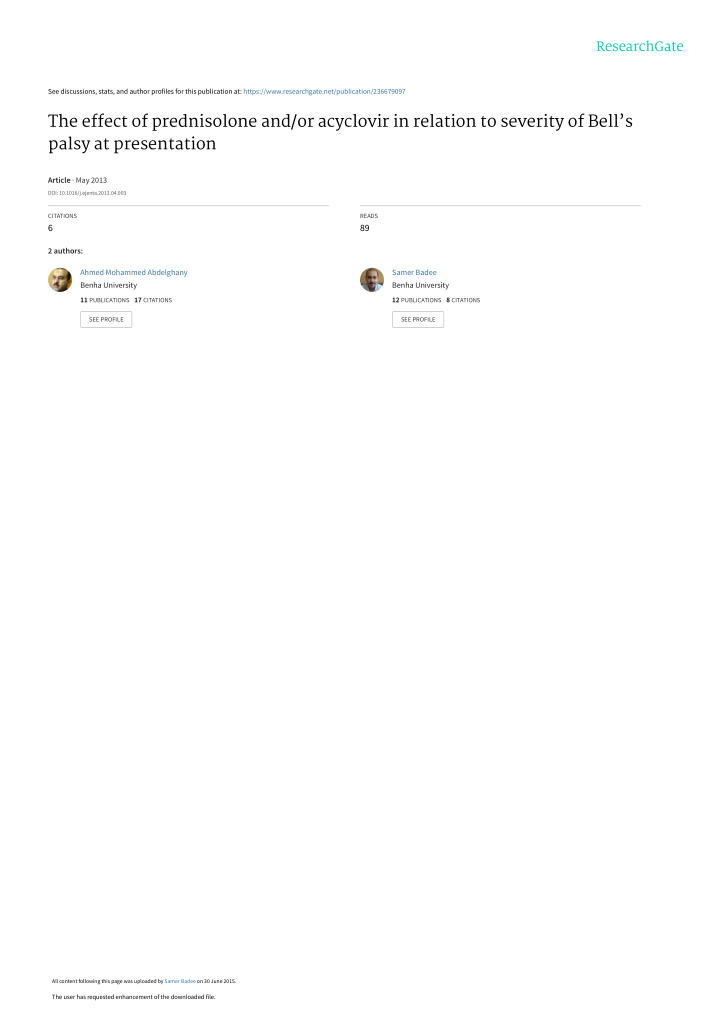



See discussions, stats, and author profiles for this publication at: https://www.researchgate.net/publication/236679097 The effect of prednisolone and/or acyclovir in relation to severity of Bell’s palsy at presentation Article · May 2013 DOI: 10.1016/j.ejenta.2013.04.003 CITATIONS READS 6 89 2 authors: Ahmed Mohammed Abdelghany Samer Badee Benha University Benha University 11 PUBLICATIONS 17 CITATIONS 12 PUBLICATIONS 8 CITATIONS SEE PROFILE SEE PROFILE All content following this page was uploaded by Samer Badee on 30 June 2015. The user has requested enhancement of the downloaded file.
Egyptian Journal of Ear, Nose, Throat and Allied Sciences (2013) 14 , 155–159 Egyptian Society of Ear, Nose, Throat and Allied Sciences Egyptian Journal of Ear, Nose, Throat and Allied Sciences www.ejentas.com ORIGINAL ARTICLE The effect of prednisolone and/or acyclovir in relation to severity of Bell’s palsy at presentation Ahmed Mohammed Abdelghany * , Samer Badee Kamel Department of Otorhinolaryngolgy, Benha University, Egypt Received 11 December 2012; accepted 9 April 2013 Available online 9 May 2013 KEYWORDS Abstract Objectives: To evaluate the efficacy of prednisolone and/or acyclovir in the treatment of Bell’s palsy in relation to severity at the first visit. Bell’s; Design: A prospective, randomised, placebo-controlled study. Prednisolone; Acyclovir; Setting: Four public outpatient ENT clinics. Severity Patients: 603 patients aged 18–70 years were treated within 72 h of palsy onset. Patients were assigned tothree groups; group 1 treated withprednisoloneplus placebo ( n = 198), group 2 treated with acyclovir plus placebo ( n = 203), and group 3 treated with prednisolone plus acyclovir ( n = 202). Each group was divided into three subgroups according to severity of palsy at presentation using the Sunny- brook score; severe; moderate and mild. Point of assessment was at the end of the 12th month. Main outcome measures: Facial function and synkinesis were evaluated for correlation to severity of palsy at baseline. Results: In patients with severe palsy, complete recovery at 12 months was 56% with prednisolone, 41.6% with acyclovir and 55.5% in prednisolone plus acyclovir group. In patients with moderate palsy, recovery was 64.5%, 56.6% and 70.2% in groups 1, 2 and 3 respectively. In patients with mild palsy, recovery was 92%, 62.6% and 91.5% in groups 1, 2 and 3, respectively. Complete recovery and absence of slinkiness results were correlated to the baseline severity. Group 3 had significant higher results in moderate palsy cases. Conclusion: Prednisolone treatment resulted in higher complete recovery rates, regardless of severity at presentation. Prednisolone treatment should be considered in all patients irrespective of degree of palsy. ª 2013 Production and hosting by Elsevier B.V. on behalf of Egyptian Society of Ear, Nose, Throat and Allied Sciences. * Corresponding author. E-mail addresses: ahmedent@gmail.com, ahmedabdelghany120@- 1. Introduction hotmail.com (A.M. Abdelghany). Peer review under responsibility of Egyptian Society of Ear, Nose, Bell’s palsy is an abrupt onset of unilateral weakness or paral- Throat and Allied Sciences. ysis of the face with no obvious cause. 1 The annual incidence is about 30 per 100,000 population, with no seasonal or geo- graphical clustering and with a peak incidence between the sec- Production and hosting by Elsevier ond and fourth decades of life. 2,3 2090-0740 ª 2013 Production and hosting by Elsevier B.V. on behalf of Egyptian Society of Ear, Nose, Throat and Allied Sciences. http://dx.doi.org/10.1016/j.ejenta.2013.04.003
Recommend
More recommend